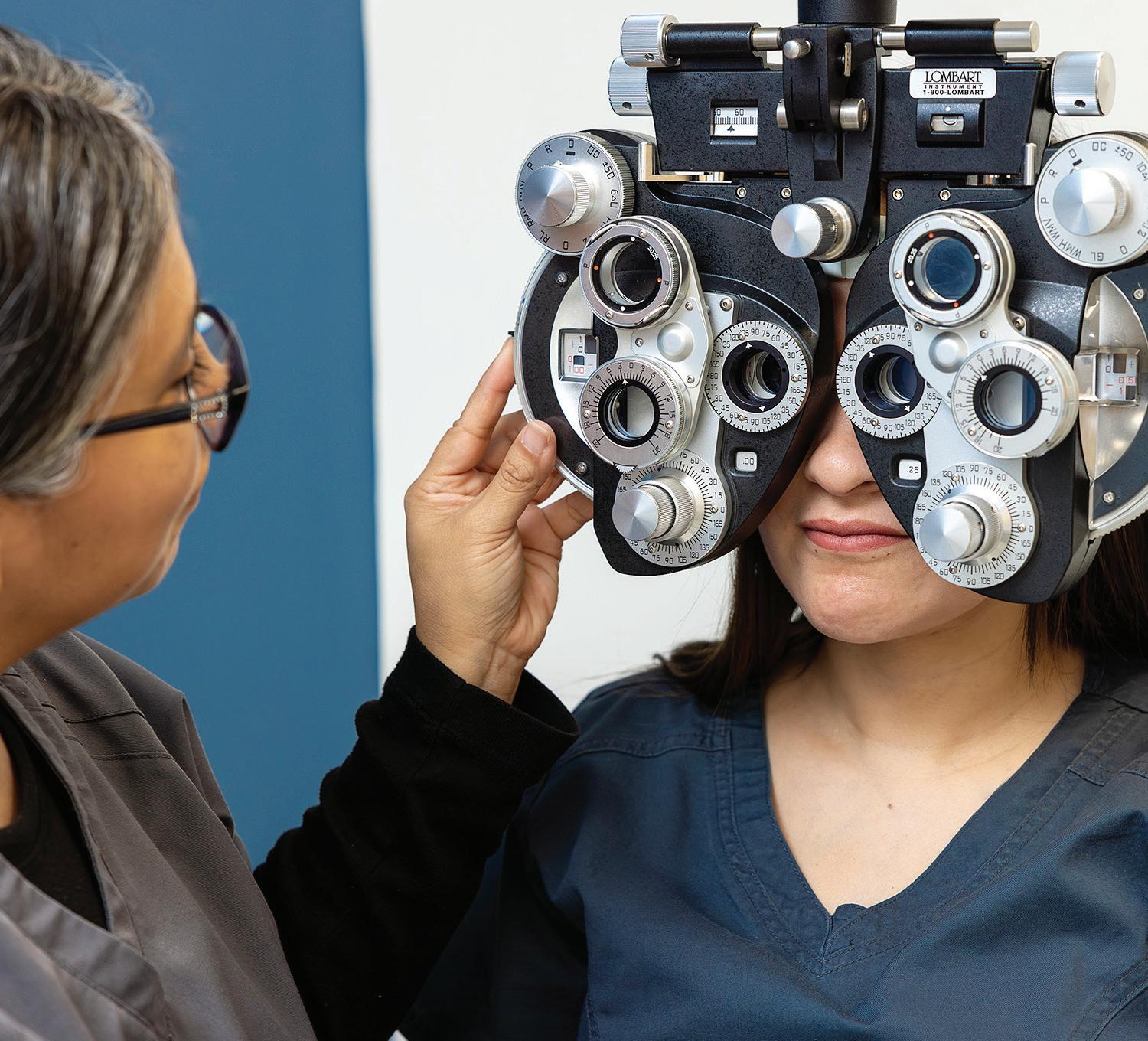

BOARD OF TRUSTEES
Teresa Ayala PRESIDENT DISTRICT 1
Kenneth Barr
VICE PRESIDENT
DISTRICT 7
Jeanne Deakyne SECRETARY
DISTRICT 3
Leonard Hornsby ASSISTANT SECRETARY DISTRICT 5
Shannon Wood DISTRICT 2
Laura Forkner Pritchett DISTRICT 4
Gwendolyn Morrison, PhD DISTRICT 6
CHANCELLOR
Elva Concha LeBlanc, PhD
About Lightcast
Lightcast is a leading provider of economic impact studies and labor market data to educational institutions, workforce planners, and regional developers in the U.S. and internationally. The present study reflects the latest version of its model, representing the most up-to-date theory for conducting human capital economic impact analyses.
While this report is useful in demonstrating the current value of Tarrant County College District, it is not intended for comparison with TCCD’s previous study conducted by Lightcast in 2016.

2 | Tarrant County College District
ABOUT US Midwest Luxury Publishing d/b/a Southern Luxury Publishing, is a full-service communications outfit made up of experienced industry experts. We are your turnkey provider for all your publishing needs. CONTACT THE PUBLISHER info@midwestluxurypublishing.com midwestluxurypublishing.com 917.447.7731 2 Letter from the Chancellor 4 Executive Summary 8 Economic Impact 18 Investment Analysis 24 Conclusion Table of Contents
Partners for Life
A Message From the Chancellor
As we contemplate the economic forces shaping Tarrant County, we must remember as college administrators to recognize the pivotal role played by institutions such as ours.
The Tarrant County College District is laser focused on advancement through knowledge and human capital. It engenders a workforce of unparalleled proficiency. That’s no small task, given the rapid growth of the North Texas region and the complexities of an evolving global economy.
The relationship between TCCD and the community is palpable. Look no further than the recent economic scan commissioned by our Institutional Research Office. Businesses and industries need a steady influx of capable, reliable employees, and Tarrant County needs to know that its community college provides a significant return on investment. This economic scan proves without doubt that TCCD is a catalyst for workforce development, fueling economic vitality and innovation.
We’re talking $2.1 billion in added income for Tarrant County, $1.7 billion of which comes from the higher earnings of TCC graduates and the increased productivity of the businesses that employ them. That’s an economic punch similar to hosting the World Series 250 times.
Our comprehensive array of academic programs, vocational training initiatives, certificate options and continuing education classes makes TCCD an institution of higher purpose. Agility is our superpower. Entrepreneurial is our mindset. We’re constantly reinventing ourselves to meet the needs of the 1,200-plus North Texas partners who support us.
And do not underestimate the ripple effects.
Our students, faculty and staff all bolster the economy, spurring demand for goods and services across myriad sectors. In addition to their spending impact, these individuals contribute to the region’s cultural richness as they integrate into the community.
The result is progress infusing the entrepreneurial landscape in many forms. Through collaborative research

and incubation programs, TCCD fosters an ecosystem conducive to groundbreaking ideas and ventures. This positions Tarrant County as a hub for breakthroughs and creativity on the global stage.
With The Lens: Special Edition magazine, we celebrate these contributions to the economic advancement and resilience of this special place we call home. In navigating the currents of change, we draw inspiration from the District’s long determination to build a future defined by prosperity, opportunity, and community.
 Elva Concha LeBlanc, PhD chancellor, tarrant county college district
Elva Concha LeBlanc, PhD chancellor, tarrant county college district
TCCD.EDU | 1

Our job is educating people for your jobs
Tarrant County College District educates, trains and certifies the workforce of tomorrow today.

Our Story, Our Impact
Since its creation in 1965, Tarrant County College District has grown exponentially. Today, TCCD is among the largest institutions in the nation.
Led by Chancellor Dr. Elva Concha LeBlanc, the District’s service region is Tarrant County.
The District helps students achieve their individual potential by developing the knowledge, skills, and abilities they needed to have fulfilling and prosperous careers and become valuable employees who increase business productivity. Beyond educating students, the District’s day-to-day operations and expenditures positively impact the county’s economy.
This economic report uses a two-fold approach to assess TCCD’s impact on the county economy and the benefits generated by the District for students, taxpayers, and society.
First, the economic analysis uses a specialized Multi-Regional Social Accounting Metric (MR-SAM) model to calculate the added income created in the Tarrant County economy as a result of increased consumer spending and the added knowledge, skills and abilities of students. The analysis is broken out according to four impacts:
1. impacts of the District’s day-to-day operations
2. impact of the District’s construction spending
3. impact of student spending
4. impact of alumni who are still employed in the Tarrant County workforce
Second, the study measures the benefits TCCD generates for three stakeholder groups: students, taxpayers, and society.
Data Sources for the Impact Study
• FY 2021-22 TCCD academic and financial reports
• Industry and employment data from the U.S. Bureau of Labor Statistics
• U.S. Census Bureau data
• Outputs of Lightcast’s impact model and MR-SAM model
• A variety of published materials relating education to social behavior
TCCD.EDU | 3

An educated workforce is your biggest competitive edge
Executive Summary
For every dollar invested in TCCD, the state receives an average return on investment of $11 over the course of students’ careers.
Tarrant County College District was established in 1965 and has grown to serve nearly 60,000 credit and 16,000 non-credit students each academic year. The District’s impact extends beyond its students, however. The programs and offerings supply employers with skilled laborers and increased productivity. To fully measure its value to the county, TCCD commissioned an economic impact report with Lightcast to assess TCCD’s Fiscal Year (FY) 202122 benefits for the Tarrant County economy. Study results demonstrate positive net impact on the county economy with an excellent return on investment for students, taxpayers, and society.
Economic Impact
During the analysis year, TCCD generated $2.1 billion in added income for the Tarrant County economy through its operations, construction, and student spending, together with the enhanced productivity of its alumni. This is equivalent to supporting 26,222 jobs and approximately 1.4 % of the total gross regional product of Tarrant County.
• Operations spending impact
Payroll and benefits supporting TCCD’s day-to-day operations equaled $228.1 million, and the District’s non-pay expenditures (excluding construction) amounted to $233.2 million. The net impact of TCCD operations was approximately $267.3 million in added income, equating to 3,605 jobs.
• Construction spending impact
TCCD creates quick infusions of income for Tarrant County through its yearly construction to accommodate growth and other demands. Construction spending during FY 2021-22 generated $46.1 million in added income, equivalent to 615 jobs.
• Student spending impact
TCCD students’ living expenses added $93.1 million to the Tarrant County economy, equivalent to supporting 1,495 jobs.
• Alumni impact
The skills students gain at TCCD lead to more productive careers, many within Tarrant County. The accumulated impact of TCCD alumni employed in the county equals $1.7 billion in added income for the county, which equates to supporting 20,507 jobs.
Investment Analysis
• Student costs and ROI
Students’ opportunity and loan costs for an education at TCCD yield $133.3 million in present-value student costs. However, students will receive a present value of $1.2 billion in increased earnings over their working lives, realizing a return of $9.20 for every $1 they invested in their education.
• Taxpayer ROI
TCCD receives $370.3 million in taxpayer support through local and state funding. In return, taxpayers receive an estimated present value of $453.6 million in added tax revenue from students’ higher lifetime earnings and increased business output. Reductions in demand for government-funded social services equal $40.2 million. For every tax dollar spent educating students at TCCD, taxpayers will receive an average $1.30 ROI over the course of students’ working lives, or an annual 1.8% rate of return.
• Social ROI
Through District expenditures, student expenses, and student opportunity costs, the people of Texas invested $642.8 million in TCCD during FY 2021-22. In return, TCCD will add an estimated $7 billion in present value over the course of students’ working lives. Reductions in crime, lower government assistance, and increased health and well-being across the state add an estimated $110.2 million in present value in social savings. For every dollar invested in TCCD, the state receives an average ROI of $11 over the course of students’ careers.
TCCD.EDU | 5
introduction

A Story Worth Telling
The impact Tarrant County College District has on the local economy.
Located in Fort Worth, Texas, Tarrant County College District has a rich history of serving students and the community since 1965 through flexible course offerings in relevant, in-demand fields. The District offers a variety of transfer, vocational and community-based classes, serving just under 60,000 students, more than 59,000 credit and about 16,000 non-credit students in FY 2021-22.
Offering exceptional educational opportunities in multiple formats, TCCD students choose from more than 240 degrees and certificate programs, including accounting, business, culinary arts, nursing, welding technology, and more. The District also offers continuing education classes to meet the needs of students and community members.
Local employers also benefit from TCCD, which adds highly trained human capital to the county workforce. The District also supports employers and businesses with the Tarrant Small Business and Development Center, helping with funding, interpreting financials and marketing strategies, all of which drive new business and new people to the area.
Methodology
This study uses two general types of information to make conclusions about TCCD’s economic impact on the District: 1) data collected from the District and 2) county economic data obtained from various public sources and Lightcast’s proprietary data modeling tools. This section provides an overview of the Tarrant County economy and the underlying information from TCCD used for this analysis.
6 | Tarrant County College District
introduction
TCCD Employee and Finance Data
Student Impact
As shown in Table 1.3, the total income, or GRP, of Tarrant County is approximately $152.2 billion, equal to the sum of labor income ($95.9 billion) and non-labor income ($56.4 billion). In Chapter 2, we use the total added income as the measure of the relative impacts of the district on the county economy.
Enrollment at TCCD has varying looks because of the range of flexible course offerings that meet the needs of students and the workforce: dual-credit programs for high schoolers, workforce or professional development programs and associate degree programs.
Figure 1.3 provides the breakdown of jobs by industry in Tarrant County. The Retail Trade sector is the largest employer, supporting 135,852 jobs or 9.6% of total employment in the county. The second largest employer is the Health Care & Social Assistance sector, supporting 128,319 jobs or 9.1% of the county’s total employment. Altogether, the county supports 1.4 million jobs.5
In 2021-2022, TCCD awarded 1,528 certificates and 5,563 associate degrees— making TCCD the ninth largest institution in the nation for awarding associate degrees.
TCCD Workforce Data
Isolating employee payroll and household expenses demonstrates the impact within Tarrant County. TCCD employed 2,093 full-time and 1,379 part-time faculty and staff, with 100% working in the county and 72% living there.
District Revenues and Expenditures
As shown in Table 1.3, the total income, or GRP, of Tarrant County is approximately $152.2 billion, equal to the sum of labor income ($95.9 billion) and non-labor income ($56.4 billion). In Chapter 2, we use the total added income as the measure of the relative impacts of the district on the county economy.
Totaling $560.3 million, only 7% of District revenues came from tuition and fees. The vast majority of revenue, 91%, came from local, state, and federal government sources. Auxiliary revenue, sales and services, interest, and donations made up the last 2%.
Figure 1.3 provides the breakdown of jobs by industry in Tarrant County. The Retail Trade sector is the largest employer, supporting 135,852 jobs or 9.6% of total employment in the county. The second largest employer is the Health Care & Social Assistance sector, supporting 128,319 jobs or 9.1% of the county’s total employment. Altogether, the county supports 1.4 million jobs.5
TCCD’s expenses came to $589.2 million, with total payroll amounting to $228.1 million. Largely consisting of operations and maintenance, the remaining expenditures totaled $361.1 million.
88%
TCCD.EDU | 7
GENDER % FEMALE MALE POC ETHNICITY % WHITE OTHER AVERAGE STUDENT AGE
GRADUATES REMAIN IN TARRANT COUNTY
26
Retail Trade Health Care & Social Assistance Transportation & Warehousing Finance & Insurance Accommodation & Food Services Administrative & Waste Services Construction Manufacturing Professional & Technical Services Other Services (except Public Administration)
100,000 60,000 40,000 20,000 0 80,000 120,000 140,000
Figure 1.3: Jobs by major industry sector in Tarrant County, 2022*
100+94+94+82+75+74+70+70+65+60+47+46+42+41+22+15+11+10+9+2+1
Retail Trade Health Care & Social Assistance Transportation & Warehousing Finance & Insurance Accommodation & Food Services Administrative & Waste Services Construction Manufacturing Professional & Technical Services Other Services (except Public Administration) Real Estate & Rental & Leasing Government, Education Wholesale Trade Government, Non-Education Arts, Entertainment, & Recreation Educational Services Information Mining, Quarrying, & Oil and Gas Extraction Management of Companies & Enterprises Agriculture, Forestry, Fishing & Hunting Utilities * Data reflect the most recent year for which data are available. Lightcast data are updated quarterly. Source: Lightcast employment data. 100+94+94+82+75+74+70+70+65+60+47+46+42+41+22+15+11+10+9+2+1 100,000 60,000 40,000 20,000 0 80,000 120,000 140,000 introduction
Figure 1.3: Jobs by major industry sector in Tarrant County, 2022*

The Tarrant County Economy
Since the District was first established in 1965, it has served Tarrant County by enriching the workforce, providing residents with easy access to opportunities in higher education and preparing students for highly skilled, technical professions. The major industrial sectors in the county align with the talent TCCD students and alumni provides. Labor and non-labor income comprise the county’s total income, also considered as the county’s gross regional product (GRP).
Tarrant County’s total income, or GRP, is approximately $152.3 billion, equal to the sum of labor income ($95.9 billion) and non-labor income ($56.4 billion). The largest employer in the county is the Retail Trade sector, supporting 135,852 jobs, followed by the Health Care & Social Assistance sector, with 128,319 jobs. Altogether, the county supports 1.4 million jobs.
Table 1.4 and Figure 1.4 present the mean earnings by education level in Tarrant County and the state of Texas at the midpoint of the average-aged worker’s career. These numbers are derived from Lightcast complete employment data on average earnings per worker in the county and the state.6 The numbers are then weighted by the district’s demographic profile, and state earnings are weighted by students’ settlement patterns. As shown, students have the potential to earn more as they achieve higher levels of education compared to maintaining a high school diploma. Students who earn an associate degree from TCCD can expect approximate wages of $44,600 per year within Tarrant County, approximately $9,200 more than someone with a high school diploma.
The mean earnings by education level in Tarrant County demonstrate the increased lifetime earning potential of obtaining an associate degree compared to completing a high school degree or less, and by extension, the potential value of an education at TCCD.
$589.2M
8 | Tarrant County College District
The Tarrant County Economy and TCCD 72% LIVE IN TARRANT COUNTY STAFF AND FACULTY
TOTAL TCCD REVENUE
REVENUE SOURCES OTHER LOCAL GOVERNMENT FEDERAL GOVERNMENT STATE GOVERNMENT TUITION AND FEES TOTAL TCCD EXPENSES
3,472
$560.3M
OPERATION AND MAINTENANCE OF PLANT SALARIES, WAGES, BENEFITS OTHER CONSTRUCTION DEPRECIATION AND INTEREST EXPENSES BY FUNCTION
Figure 1.4: Average earnings by education level at a TCCD student’s career midpoint
Education level Regional earnings Difference from next lowest degree State earnings Difference from next lowest degree Less than high school $27 400 n/a $27 500 n/a High school or equivalent $35 400 $8 000 $35 400 $7 900 Certificate $38 900 $3 500 $39 000 $3 600 Associate degree $44 600 $5 700 $44 600 $5 600 Bachelor’s degree $64 400 $19 800 $64 500 $19 900 Source: Lightcast employment data. Source: Lightcast employment data. < High school High school Certificate Associate Bachelor's 41+55+63+71+100 41+55+63+71+100 County earnings State earnings $60K $50K $40K $30K $20K $0 $10K $70K economic impact
Table 1.4: Average earnings by education level at a TCCD student’s career midpoint
Nothing works like a properly trained workforce

Training Day
The impact Tarrant County College District has on workforce and economic development.
Evaluating the impact of the Tarrant County College District’s operations, construction, and student spending as well as the District’s alumni impact is an empirical way to measure TCCD’s economic impact.
Using net instead of gross economic impacts as a truer measure, the analysis asked the following hypothetical question: How would economic activity change in Tarrant County if TCCD and its alumni did not exist in FY 2021-22?
Specifically, the study assessed changes in income, similar to the commonly used gross regional product (GRP), which may be broken out into labor income impact, or earnings, and non-labor income impact. Labor and non-labor impact equal total income. Added labor and non-labor income, total income, jobs, and sales are all used to estimate the economic impact presented.
TCCD.EDU | 9
economic impact

Operations Spending Impact
Payroll, operations expenditures, and employee and student spending in Tarrant County all support county business, creating a ripple effect that generates still more jobs and higher wages throughout the economy. This study maps the three areas of TCCD expenditures—salaries, wages, and benefits; operations and maintenance; and all other expenditures—onto other typical expenditures as determined by Lightcast’s MR-SAM model. This is how the analysis arrived at the economic impacts of TCCD.
Based on these calculations, the total net impact of TCCD is approximately $257.6 million in labor income and $9.7 million in non-labor income, or $267.3 million in total added income. This is the equivalent of supporting 3,605 jobs and represents new economic activity created in the county solely attributable to the operations of TCCD.
10 | Tarrant County College District
The $416 million in gross impact is often reported by researchers as the total impact. We go a step further to arrive at a net impact by applying a counterfactual scenario, i.e., what
Labor income (thousands) Non-labor income (thousands) Total income (thousands) Sales (thousands) Jobs supported Initial effect $228,100 $0 $228,100 $461,301 3,472 Multiplier effect Direct effect $36,374 $22,900 $59,274 $125,363 440 Indirect effect $12,299 $6,672 $18,971 $41,979 151 Induced effect $59,125 $50,535 $109,661 $187,401 995 Total multiplier effect $107,798 $80,108 $187,906 $354,743 1,586 Gross impact (initial + multiplier) $335,898 $80,108 $416,006 $816,044 5,058 Less alternative uses of funds -$78,336 -$70,432 -$148,769 -$246,266 -1,453 Net impact $257,562 $9,676 $267,237 $569,778 3,605 Source: Lightcast impact model. economic impact
Table 2 .2: Operations spending impact, FY 2021-22

Construction Spending Impact
Construction funding at Tarrant County College District is separate from operations funding in budgeting, and therefore is not captured in the operations spending impact section. During this fiscal year, the District spent a total of $86.4 million on various construction projects. This area of spending, however, creates subsequent rounds of spending and multiplier effects that generate still more jobs and income throughout the county. The non-labor income impact in this area is relatively small given the labor-intensive nature of construction.
Campus Renovations
Northwest and Southeast campus redevelopment projects comprised TCCD construction projects during FY 2021-22.
The FY 2021-22 TCCD construction spending created a net total short-run impact of $47 million in labor income and $974.5 thousand in non-labor income. This equals $46.1 million in added income, the equivalent of supporting 615 jobs in the county.
TCCD.EDU | 11
economic impact

Student Spending Impact
Atotal of $93.1 million in county income and the equivalent of supporting 1,495 jobs were added due to the activities of these retained and relocated TCCD students.
This analysis measured the impact of 7,445 TCCD students who were either retained or relocated in Tarrant County in direct relation to the District. Both county residents and non-residents contribute to TCCD’s student spending impact, but only students who would have left the county for an education elsewhere had they not attended TCCD are measured in this study.
Retention Numbers
This study measured the economic impact of a total 7,445 students, 5,363 of whom were retained students whose impact was solely attributable to the District and would have left the county otherwise. An estimated 2,082 relocated students who came from outside the county and lived off-campus.
Of the 53,626 total students attending the District in FY2021-22, Lightcast conservatively estimated that 10% of them qualified as “retained” students. These are students who live and spend money through activities like buying groceries and transportation in the county. An estimated 2,082 relocated students who came from outside the county and lived off-campus were also included in the study, since they supported jobs and created income in the county economy.
Altogether, these students generated net off-campus sales into the Tarrant County economy of $113.2 million by patronizing local businesses during FY 2021-22. The total impact of student spending was $57.5 million in labor income and $35.6 million in non-labor income for a total of $93.1 million in total added income, which is the equivalent to supporting 1,495 jobs.
12 | Tarrant County College District
economic impact

TCCD Alumni Impact

TThe other adjustment in Table 2.6 accounts for the importation of labor. Suppose TCCD did not exist and in consequence there were fewer skilled workers in the county. Businesses could still satisfy some of their need for skilled labor by recruiting from outside Tarrant County. We refer to this as the labor import effect. Lacking information on its possible magnitude, we assume 50% of the jobs that students fill at county businesses could have been filled by workers recruited from outside the county if the district did not exist.17 Consequently, the gross labor income must be adjusted to account for the importation of this labor, since it would have happened regardless of the presence of the district. We conduct a sensitivity analysis for this assumption in Appendix 1. With the 50% adjustment, the net added labor income added to the economy comes to $628.1 million, as shown in Table 2.6.
he greatest impact of TCCD stems from its added human capital—the knowledge, creativity, imagination, and entrepreneurship found in its alumni.
These talented professionals, in turn, make businesses more productive. Unlike previous sections, the alumni impact analysis draws upon past data as well as estimates of alumni still employed in the workforce.
Leaving a Mark
Ultimately, the alumni base created $549.3 million in labor income and $238.5 million in non-labor income, for a total of $787.8 million in multiplier effects.
Using the 9.5 average Credit Hour Equivalents (CHEs), which symbolize 15 hours of instructional contact time per credit hour, the analysis multiplied that number against the estimated headcount of alumni deemed to be actively employed. With no duplication in CHE counts, the study estimates there are approximately 14.1 million CHEs from alumni active in the workforce. The estimated value of the CHEs equals $105, representing the incremental wage increases TCCD alumni received during the analysis year.
Combining initial labor and non-labor income, the estimated total initial effect of alumni productivity in the Tarrant County economy equals approximately $892.7 million. Multiplier effects again occur through increased demand for consumer goods and services due to higher TCCD alumni wages.
Therefore, the estimated total TCCD alumni impact is $1.7 billion in total added income, the equivalent of supporting 20,507 jobs.
The $628.1 million in added labor income appears under the initial effect in the labor income column of Table 2.7. To this we add an estimate for initial non-labor income. As discussed earlier in this section, businesses that employ former students of TCCD see higher profits as a result of the increased productivity of their capital assets. To estimate this additional income, we allocate the initial increase in labor income ($628.1 million) to the six-digit NAICS industry sectors where students are most likely to be employed. This allocation entails a process that maps completers in the county to the detailed occupations for which those completers have been trained, and then maps the detailed occupations to the six-digit industry sectors in the MR-SAM model.18
TCCD.EDU | 13
Using a crosswalk created by National Center for Education Statistics (NCES) and the Bureau of Labor Statistics, we map the breakdown of the district’s completers to the
Labor income (thousands) Non-labor income (thousands) Total income (thousands) Sales (thousands) Jobs supported Initial effect $628,080 $264,617 $892,697 $1,817,425 10,802 Multiplier effect Direct effect $151,855 $62,943 $214,798 $434,504 2,851 Indirect effect $64,916 $27,383 $92,299 $188,496 1,220 Induced effect $332,540 $148,160 $480,700 $915,382 5,633 Total multiplier effect $549,311 $238,487 $787,798 $1,538,382 9,705 Total impact (initial + multiplier) $1,177,391 $503,103 $1,680,495 $3,355,808 20,507 Source: Lightcast impact model. economic impact
Table 2 .7: Alumni impact, FY 2021-22
Total TCCD Impact
One out of every 54 jobs in Tarrant County is supported by the activities of TCCD and its students. Every year, former TCCD students add to the human capital and the economy in Tarrant County. This meets the District’s basic mission, but the impact can be quantified far beyond a mission statement, however.
The total added value of TCCD is $2.1 billion, equivalent to 1.4% of the Tarrant County GRP. The District’s total impact supported 26,222 jobs in FY 2021-22. This impact spreads across industries.

These impacts from the district and its students stem from different industry sectors and spread throughout the county economy. Table 2.9 displays the total impact of TCCD by each industry sector based on their two-digit NAICS code. The table shows the total impact of operations, construction, students, and alumni, as shown in Table 2.8, broken down by each industry sector’s individual impact on the county economy using processes outlined earlier in this chapter. By showing the impact from individual industry sectors, it is possible to see in finer detail the industries that drive the great est impact on the county economy from the spending of the district and its students and from where TCCD alumni are employed. For example, among the non-Education industries, the spending of TCCD and its students as well as the activities of its alumni in the Finance & Insurance industry sector generated an impact of $173.7 million in FY 2021-22.
Table 2 .9: Total TCCD impact by industry, FY 2021-22
Source: Lightcast impact model. 100+87+60+59+50+47+44+43+41+31+30+24+23+21+13+8+8+6+6+5+1 100+97+20+24+40+17+57+28+36+34+16+7+17+30+32+11+13+1+4+1+1
14 | Tarrant County College District
Industry sector Total income (thousands) Jobs supported Government, Education $292,080 4,408 Retail Trade $253,867 4,299 Wholesale Trade $173,831 899 Finance & Insurance $173,709 1,074 Construction $147,277 1,802 Manufacturing $140,078 782 Real Estate & Rental & Leasing $130,320 2,538 Professional & Technical Services $126,482 1,271 Health Care & Social Assistance $120,609 1,605 Administrative & Waste Services $91,141 1,509 Government, Non-Education $87,737 748 Information $70,877 329 Transportation & Warehousing $68,562 755 Accommodation & Food Services $62,266 1,337 Other Services (except Public Administration) $40,473 1,416 Educational Services $24,988 524 Arts, Entertainment, & Recreation $24,366 597 Mining, Quarrying, & Oil and Gas Extraction $19,959 69 Management of Companies & Enterprises $18,343 192 Utilities $17,040 30 Agriculture, Forestry, Fishing, & Hunting $2,897 39 Total impact $2,086,902 26,222
economic impact

At a Glance
Operations Total Net Spending Impact
$267.3 million in total added income—the equivalent of supporting 3,605 jobs
Construction Spending Impact
$46.1 million in added income, the equivalent of supporting 615 jobs in the county
Student Spending Impact
$93.1 million in county income and the equivalent of supporting 1,495 jobs
Alumni Impact
$549.3 million in added labor income and $238.5 million in non-labor income, for a total of $787.8 million in multiplier effects
$1.7 billion in total added income, the equivalent of supporting 20,507 jobs
Total Impact
The total added value of TCCD is $2.1 billion, equivalent to 1.4% of the Tarrant County GRP.
The District’s total impact supported 26,222 jobs.
One in 54 jobs in the county is supported by TCCD and students’ activities.
economic impact







TCCD
Trailblazers are doing more to make our region, our state, and our world a better place


Investment Analysis
TCCD’s total social savings and the increased state economic base equals $7.1 billion.
The Tarrant County College District’s most obvious beneficiaries are its students, but their human capital, increased wages, and spending in communities benefit communities and businesses in Texas and beyond.
Investment analysis is the process of evaluating total costs and measuring these against total benefits to determine whether or not a proposed venture will be profitable. If benefits outweigh costs, then the investment is worthwhile. If costs outweigh benefits, the investment loses money and is considered infeasible.
We evaluate TCCD as a worthwhile investment from the perspectives of students, taxpayers, and society.
Student Perspective
From a student’s perspective, education is the same as an investment. They incur costs, put up a certain amount of money, and expect to receive benefits in return. This section discusses the benefits of investing in a TCCD education.
During FY 2021-22, students paid a total of $42 million in tuition and fees and $36.5 million for books and supplies, or $1,728 per full-time student, on average, for books and supplies. Students received a total of $15.9 million in federal loans to attend TCCD.
Estimating opportunity costs, while challenging, measures the value of time and earnings students forego to get an education rather than work full-time. Opportunity costs for students who do not work while attending TCCD equal $91.3 million; for those who work, it is $95 million. The study estimated that 81% of TCCD students were employed, although employed students hold jobs that pay less than the statistical average to accommodate their course schedules.


One year of student loans incurred for TCCD students equals $15.9 million, averaging $3,205 per student for the analysis year. Although the U.S. Department of Education estimates an average of 10 years to repay this level of debt, Lightcast calculates the time value of money and that students will pay a total discounted present value of $3.2 million in interest and $12.4 million in principal on student loans.
Summing direct outlays, opportunity costs, and future student loans yields a total of $133.3 million in present value student costs.
Linking Education to Earnings
The study then weighs student costs against the benefits students receive in return. A key component in this calculation is the value of their future benefits stream, or what they can expect to earn in return for the investment they make in education. From Year Zero to Year 40, the projected net higher earning benefits for students increase from $6.7 million to $65 million, and their net cash flow goes from -$110.9 million to $65 million.
Most importantly, students are projected to receive a 9.2 benefit-to-cost ratio with an internal rate of return of 30% for investing in their education at TCCD. The aggregate FY 2021-22 student body is rewarded for its investment in TCCD with a capital asset valued at $1.2 billion. Students’ cost of attending equals a present value of $133.3 million. Finally, TCCD students only have a payback period of 4.6 years. This means that after their initial investment of forgone earnings and out-of-pocket costs, they will have received enough higher future earnings to recover those costs fully.
TCCD.EDU | 19
investment analysis
avoided medical costs that would have otherwise been covered by state and local government. Crime savings consist of avoided costs to the justice system (i.e., police protection, judicial and legal, and corrections). Income

Taxpayer Perspective
of health, crime, and income assistance.39 Finally, we apply the same adjustments for attrition, alternative education, and the shutdown point to derive the net savings to the government. Total government savings appear in Figure 3.2 and sum to $40.2 million.
As a result of their time at TCCD, students earn more because of the skills they learned, and businesses earn more because student skills make capital more productive (buildings, machinery, and everything else). This, in turn, raises profits and other business property income. Together, increases in labor and non-labor (i.e., capital) income are considered the effect of a skilled workforce, which increases tax revenues since state and local government is able to apply tax rates to higher earnings.
Table
After adjusting for attrition, alternative education opportunities, and the shutdown point, Lightcast calculated the present value of the future added tax revenues that occur in the state at $453.6 million.
Education is statistically associated with a variety of lifestyle changes that encourage social savings, also known as external or incidental benefits of education. These represent the avoided costs to the government that otherwise would have been drawn from public resources absent the education provided by TCCD including health, crime, and income assistance savings. Government savings totals $40.2 million.
Lightcast impact model.
39 For a full list of the data sources used to calculate the social externalities, see the Resources and References section. See also Appendix 10 for a more in-depth description of the methodology.
Finally, taxpayers accrue substantial benefits in other ways as well. Added tax revenues equal $453.6 million from students’ higher earnings, increases in non-labor income, and spending impacts. The sum of the government savings and the added income in the state is $493.8 million. These savings continue to accrue in the future as long as the FY 2021-22 student population of TCCD remains in the workforce.
Taxpayer costs come to $370.3 million, equal to the contribution of state and local governments to TCCD. Importantly, in return for their public support, taxpayers are rewarded with an investment benefit-cost ratio of 1.3 (= $493.8 million ÷ $370.3 million), indicating a profitable investment.
Figure 3.2: Present value of
35 3035 U$40.2 million Total government savings
Source: Lightcast impact
20 | Tarrant County College District
48 Chapter 3: Investment analysis
In addition to the creation of higher tax revenues to the state and local government, education is statistical-
government savings Income assistance $14.2
Health $11 2 million Crime $14 7 million
million
model.
Added tax revenue $453,582 Government savings Health-related savings $11,245 Crime-related savings $14,710 Income assistance savings $14,230 Total government savings $40,185 Total taxpayer benefits $493,768
investment analysis
3 .3: Present value of added tax revenue and government savings (thousands)
Source:

Social Perspective
Texas benefits from the education that TCCD provides through the earnings students create in the state and the savings they generate through their improved lifestyles. To receive these benefits, however, members of society must pay money and forego services that they otherwise would have enjoyed if TCCD did not exist. Society’s investment in TCCD stretches across a number of investor groups, from students to employers to taxpayers. Lightcast’s study weighs the benefits generated by TCCD to these investor groups against the total social costs of generating those benefits. The total social costs include all TCCD expenditures, all student expenditures (including interest on student loans), less tuition and fees, and all student opportunity costs, totaling a present value of $642.8 million.
Any benefits that accrue to Texas as a whole are counted as benefits under the social perspective. This study groups these benefits into two broad categories: 1) increased earnings in the state and 2) social externalities stemming from improved health, reduced crime, and reduced unemployment in the state.
State Economic Base Growth
Estimating the effect of TCCD on the state’s economic base follows a similar process used when calculating increased tax revenues from the taxpayer perspective. However, instead of looking at just the tax revenue portion,
Lightcast included all of the added earnings and business output. This study calculates that the present value of the future added income in the state equals $7 billion.
Social Savings and Return on Investment
Society as a whole sees savings due to external or incidental benefits of education, representing the avoided costs that would have otherwise been drawn from private and public resources absent the education provided by TCCD. These three categories are health savings, crime savings, and income assistance savings.
It is calculated that the overall health savings for society is $78.1 million, crime savings is $17.9 million, and reduced income assistance savings is $14.2 million. All told, social savings total $110.2 million in benefits to communities and citizens in Texas.
The sum of the social savings and the increased state economic base is $7.1 billion. These savings accrue in the future as long as the FY 2021-22 student population of TCCD remains in the workforce.
Comparing the present value of the benefits and the social costs, we have a benefit-cost ratio of 11.0. This means that for every dollar invested in an education from TCCD, whether it is the money spent on operations of the district or money spent by students on tuition and fees, an average of $11 in benefits will accrue to society in Texas.
TCCD.EDU | 21
investment analysis

company
Your
is only as good as its people

Moving Forward
TCCD gives back to the community while educating students and supporting alumni endeavors
In order to fully assess TCCD’s value to the county economy, this report evaluated the District’s economic impact and return on investment.
From an economic impact perspective, this study concluded that TCCD generates a total economic impact of $2.1 billion in total added income for the county economy. This represents the sum of several different impacts, including the District’s:
• Operations spending impact ($267.3 million)
• Construction spending impact ($46.1 million)
• Student spending impact ($93.1 million)
• Alumni impact ($1.7 billion)
The total impact of $2.1 billion is equivalent to approximately 1.4% of the total GRP of Tarrant County and is equivalent to supporting 26,222 jobs. For perspective, this means that one out of every 54 jobs in Tarrant County is supported by the activities of TCCD and its students.
TCCD is an investment for students, taxpayers, and society. With this in mind, this analysis also considered the District as an investment to see the value it provides to these investors. For each dollar invested by students, taxpayers, and society, TCCD offers a benefit of $9.20, $1.30, and $11, respectively. In short, TCCD more than pays for the investment in its students, services, and programs for all stakeholders involved.
These results indicate that TCCD is attractive to students, with return rates exceeding alternative investment opportunities. At the same time, the presence of the District expands the state economy and creates a wide range of positive social benefits that accrue to taxpayers and society in general within Texas.

24 | Tarrant County College District
your workforce solutions
We’re
partner







 Elva Concha LeBlanc, PhD chancellor, tarrant county college district
Elva Concha LeBlanc, PhD chancellor, tarrant county college district






























